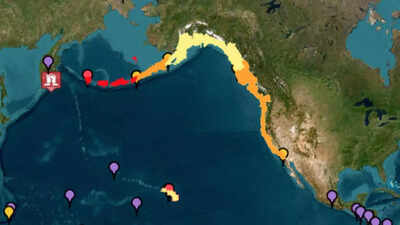Explained: What Tsunami Warning, Alert and Advisory mean and how they are different from each other

An earthquake of magnitude 8.8 hit the coast of Russia earlier today, generating Tsunami warnings and advisories for a broad section of the Pacific Ocean. These include regions of Alaska, Hawaii and the US West Coast. According to the US Geological Survey, the earthquake was centred off the coast of Kamchatka Peninsula. Dave Snider, tsunami warning coordinator at the National Tsunami Warning Center in Alaska, described the earthquake as “absolutely notable” and “a significant earth event.” In the backdrop of these strong tremor, the US National Weather Service has warned waves as high as 5.5 feet could hit the coast near Crescent City in Northern California, around 20 miles south of the Oregon border, just before midnight Pacific time. People in the warning area have been advised to move inland and stay away from the coast. Notably, Tsunami warnings have been issued for Hawaii, Alaska, and other areas, while tsunami watches and advisories are in place along the entire West Coast of the United States. In this article, we will explain what these warnings mean and how they are different from each other
What is a Tsunami
Tsunamis are giant waves caused by earthquakes or volcanic eruptions under the sea. As defined on US agency National Oceanic and Atmospheric Administration (NOAA) website, Tsunami waves do not dramatically increase in height out in the sea, but as the waves travel inland, they build up to higher and higher heights as the depth of the ocean decreases. Also, the speed of tsunami waves depends on ocean depth rather than the distance from the source of the wave. Tsunami waves may travel as fast as jet planes over deep waters, only slowing down when reaching shallow waters.
Different types of Tsunami alerts
When a Tsunami threat emerges, agencies issue alerts in three distinct categories – warnings, advisories, and watches — each indicating a different level of risk and urgency for people in coastal areas.
Tsunami Warning
A tsunami warning is the most serious of the three. It means a tsunami is either already occurring or is expected to hit soon. In such cases, residents in affected coastal zones are urged to evacuate immediately and move inland or to higher ground. For example, in Hawaii, warnings are often accompanied by sirens and text messages, advising people to avoid beaches, harbors, and other waterfront areas due to the high risk of flooding and dangerous waves.
Tsunami Advisory
A tsunami advisory is issued when a tsunami is not likely to cause major flooding but may still lead to strong currents or waves dangerous to people in or near the water. Under an advisory, officials typically ask residents to stay away from the shoreline, avoid entering the water, and be cautious around harbors and marinas.
Tsunami Watch
A tsunami watch is less urgent and means there is a potential threat, but authorities do not yet have enough information to issue a warning or advisory. It serves as an early alert, encouraging people to stay informed and monitor official updates. In some cases, a watch may later be upgraded.





